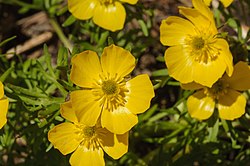Biology:Ranunculus adoneus
| Ranunculus adoneus | |
|---|---|

| |
| Scientific classification | |
| Kingdom: | Plantae |
| Clade: | Tracheophytes |
| Clade: | Angiosperms |
| Clade: | Eudicots |
| Order: | Ranunculales |
| Family: | Ranunculaceae |
| Genus: | Ranunculus |
| Species: | R. adoneus
|
| Binomial name | |
| Ranunculus adoneus A.Gray[1]
| |
Ranunculus adoneus, the alpine buttercup[2] or snow buttercup, is a species of flowering plant. It is an alpine buttercup from the family Ranunculaceae. This species is mainly found in the Rocky Mountains in Colorado and Wyoming but can also be found in Idaho, northern Utah and eastern Nevada. Its typical habitat is short grass meadows near the edge of melting snow.
Discovery
Ranunculus adoneus was first formally described in 1863 by Asa Gray in a list of species collected by several colleagues during the summer and autumn of 1862 on and near the Rocky Mountains in Colorado.[3][4]
Habitat and ecology
Ranunculus adoneus is a native species that is found only in the Rocky Mountains around the limit of snow where it is quite common.[5] It is a long-lived perennial that is found at elevated meadows in alpine environments. The plants emerge at the edge of the melting snow and flower within a few days. The flowering time of R. adoneus is controlled by the time of snowmelt, so that on a steep gradient flowers appear first on a lower altitude and subsequently, with melting of the snow, several tens of meters higher. They are found at an altitude of 2500 – 4000 meters. Flowering lasts longer at lower altitudes.[6][7][8] The flowers persist for approximately 10 days. Secondary flowers may open a week or two after the primary flowers.[8]
Morphology
The leaves of R. adoneus are about 4 cm in diameter and deeply dissected into linear lobes, with narrow leaf segments that grow at the base and along the stem and are often just one pair. The stem, which is about 9–25 cm long, is hairless and quite thick and ascends erect from the roots (caudices). It bears 1 to 3 flowers that are yellow with 5 to 10 wedge-shaped petals.[9] The flowers are larger than the leaves, about 4 cm and are situated low in the young plant but become higher through stem elongation in the summer. The flowers are protogynous: the pistils mature before the maturation of the anthers to prevent self-fertility.
The flower has 5 greenish-yellow sepals that have white hairs on the lower surface. Petals are overlapping and curved-up towards the tip so the flower is cup-shaped.
Receptacles bear 50–150 stigmas, which mature over several days. Photosynthetic achenes, the fruit that contains a seed, develop from the fertilized ovules. Seeds disperse mainly by gravity 3 to 5 weeks after fertilization.[8]
Heliotropism
The flowers present heliotropism, a property that is often present in alpine and arctic plants. It allows the flowers to track the sun, warm up and attract insects[10] In fact, when the flowers are not within 45° in line with the sun, and less insects visit the flower, the seed yield is much less.[11]
References
- ↑ "Ranunculus adoneus". Plants of the World Online. https://powo.science.kew.org/taxon/urn:lsid:ipni.org:names:217101-2.
- ↑ "Ranunculus adoneus". Natural Resources Conservation Service PLANTS Database. USDA. https://plants.usda.gov/core/profile?symbol=RAAD.
- ↑ Gray, Asa; Hooker, Joseph D. (1881) (in en). The Vegetation of the Rocky Mountain Region and a comparison with that of other parts of the world. Authors edition. pp. 4. ISBN 978-3-337-38172-1. OCLC 1189712821. http://worldcat.org/oclc/1189712821.
- ↑ Gray, Asa (1863). "Enumeration of the Species of Plants Collected by Dr. C. C. Parry, and Messrs. Elihu Hall and J. P. Harbour, during the Summer and Autumn of 1862, on and near the Rocky Mountains, in Colorado Territory, lat. 39°-41°". Proceedings of the Academy of Natural Sciences of Philadelphia 15: 56. https://www.biodiversitylibrary.org/item/18294#page/62/mode/1up.
- ↑ Southwest, The American. "Alpine Buttercup, Ranunculus Adoneus". https://www.americansouthwest.net/plants/wildflowers/ranunculus-adoneus.html.
- ↑ Stanton, M. L.; Galen, C.; Shore, J. (1997-02-01). "Population Structure Along a Steep Environmental Gradient: Consequences of Flowering Time and Habitat Variation in the Snow Buttercup, Ranunculus adoneus". Evolution 51 (1): 79–94. doi:10.2307/2410962. ISSN 0014-3820. PMID 28568788. http://dx.doi.org/10.2307/2410962.
- ↑ Denver, Botanic Gardens (2018) (in en). Wildflowers of the Rocky Mountain region. Timber Press. pp. 401. ISBN 978-1-60469-644-8. OCLC 1030444975. http://worldcat.org/oclc/1030444975.
- ↑ 8.0 8.1 8.2 Baack, Eric J. (2005-11-01). "Ecological factors influencing tetraploid establishment in snow buttercups ( Ranunculus adoneus , Ranunculaceae): minority cytotype exclusion and barriers to triploid formation" (in en). American Journal of Botany 92 (11): 1827–1835. doi:10.3732/ajb.92.11.1827. ISSN 0002-9122. PMID 21646100. https://onlinelibrary.wiley.com/doi/10.3732/ajb.92.11.1827.
- ↑ "Ranunculus adoneus - FNA". http://beta.floranorthamerica.org/Ranunculus_adoneus.
- ↑ Sherry, R. A.; Galen, C. (2002-03-01). "The mechanism of floral heliotropism in the snow buttercup, Ranunculus adoneus" (in en). Plant, Cell and Environment 21 (10): 983–993. doi:10.1046/j.1365-3040.1998.00336.x. ISSN 0140-7791. http://doi.wiley.com/10.1046/j.1365-3040.1998.00336.x.
- ↑ Stanton, Maureen L.; Galen, Candace (1989-03-01). "Consequences of flower heliotropism for reproduction in an alpine buttercup (Ranunculus adoneus)" (in en). Oecologia 78 (4): 477–485. doi:10.1007/BF00378737. ISSN 1432-1939. PMID 28312176. https://doi.org/10.1007/BF00378737.
Wikidata ☰ Q5549246 entry
 |

